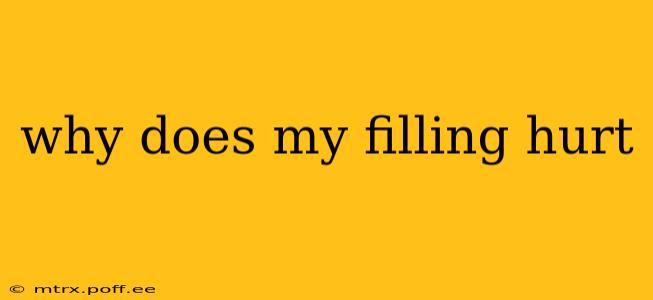A tooth filling, while designed to protect and restore a damaged tooth, can sometimes cause pain. This pain can range from a mild ache to a sharp, throbbing sensation, and understanding its cause is crucial for effective treatment. This comprehensive guide will explore the various reasons why your filling might be hurting, helping you understand when to seek professional dental care.
Common Causes of Filling Pain
Several factors can contribute to post-filling discomfort. Let's explore some of the most frequent culprits:
1. Irritation of the Tooth Nerve:
This is a common reason for post-filling sensitivity. During the filling procedure, the dentist may inadvertently irritate the nerve within the tooth. This can lead to pain, especially when exposed to hot or cold temperatures, sweet foods, or pressure. The sensitivity usually subsides within a few days or weeks as the tooth heals.
2. High Bite:
If the filling is too high, it can alter your bite and put excessive pressure on the tooth. This pressure can cause pain and discomfort, especially when chewing. You might notice pain only when biting down on that particular tooth.
3. Infection or Inflammation:
Bacteria can sometimes invade the tooth despite the filling. This can lead to inflammation or infection around the filling, causing pain and potentially more serious complications. Symptoms may include swelling, redness, and persistent pain that doesn't improve.
4. Cracked or Fractured Tooth:
Underlying cracks or fractures in the tooth can worsen after a filling procedure, leading to pain. The filling itself might not be the direct cause of the pain, but rather a symptom of a more significant underlying issue.
5. Secondary Caries (Cavities):
A new cavity can develop around the edges of an old filling, leading to pain. This is often caused by inadequate sealing of the filling or poor oral hygiene. Early detection is critical in preventing further damage.
6. Sinus Infection:
Believe it or not, a sinus infection can sometimes refer pain to the upper teeth. If the pain is located in the upper molars, a sinus infection might be the unexpected culprit. This is especially true if the pain is accompanied by other sinus symptoms like congestion or pressure.
When to See a Dentist
While some minor post-filling sensitivity is normal, persistent or severe pain requires immediate dental attention. Here are some warning signs that indicate you should schedule an appointment:
- Intense or throbbing pain: Pain that doesn't subside after a few days warrants a visit.
- Swelling or redness: These signs suggest an infection.
- Pain that radiates to other teeth or areas of the face: This could indicate a more serious underlying issue.
- Sensitivity to hot and cold that doesn't improve: Persistent sensitivity that doesn't diminish over time needs evaluation.
- Pain when chewing or biting: A high bite or underlying tooth problem might be the cause.
Preventing Filling Pain
Maintaining good oral hygiene is key to preventing filling-related problems. This includes:
- Brushing twice daily: Use a fluoride toothpaste.
- Flossing daily: Removes food particles and plaque.
- Regular dental checkups: Allows for early detection of potential problems.
- Maintaining a healthy diet: Limiting sugary foods and drinks reduces the risk of cavities.
By understanding the potential causes of filling pain and taking preventative measures, you can help ensure a comfortable and healthy smile. If you're experiencing pain, don't hesitate to contact your dentist for an evaluation and appropriate treatment.
